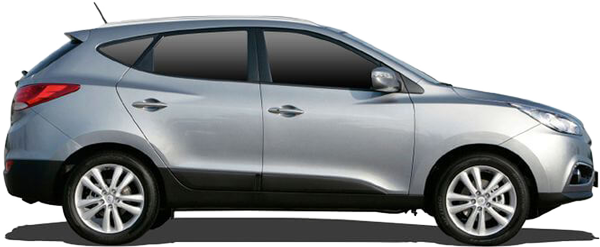The Comparative Analysis :
VW Tiguan 2.0 TSI OPF 4MOTION DSG (18 - 20) vs. Hyundai ix35 Fuel Cell (15 - 18)
€ 43,200

€ 65,500

€ 43,200
Base Price ⓘBase price of a new vehicle with standard equipment in Germany at market launch.
€ 65,500
ⓘBase price of a new vehicle with standard equipment in Germany at market launch. Price Info
Vehicle Dimensions
The dimensions of these vehicles differ slightly. The VW Tiguan 2.0 TSI OPF is 7.6 cm longer, 1.9 cm wider and 1.2 cm lower than the Hyundai ix35 Fuel Cell.
VW Tiguan 2.0 TSI OPF
Hyundai ix35 Fuel Cell
1643
1839
2099
1655
1820
2100
1839 mm
Width
1820 mm
2099 mm
Width Incl. Mirrors
2100 mm
1643 mm
Height
1655 mm
2677
4486
2640
4410
4486 mm
Length
4410 mm
2677 mm
Wheelbase
2640 mm
Vehicle Weight
VW Tiguan 2.0 TSI OPF
Hyundai ix35 Fuel Cell
1710 kg
Kerb Weight
1921 kg
2250 kg
Gross Vehicle
Weight
Weight
2250 kg

Weight Difference:
211 kg
10.98 %

General
VW Tiguan 2.0 TSI OPF
Hyundai ix35 Fuel Cell
5N
Generation
EL
Sport Utility Vehicle
Car Body Style
Sport Utility Vehicle
Unleaded (95 RON)
Fuel Type
Hydrogen

Permanent all-wheel drive
Drive
Front-wheel drive

7-speed dual clutch transmission
Transmission
1-speed automatic transmission
Engine
VW Tiguan 2.0 TSI OPF
Hyundai ix35 Fuel Cell
Straight-four petrol engine with turbocharger
Engine Type
Asynchronous motor
*DKT*
Engine Code
4
Valves
0
4
Cylinders
0
1984 CC
Engine Capacity
0 CC
227 bhp
at 4500 rpm
Power
134 bhp
at 0 rpm
VW Tiguan 2.0 TSI OPF
227 bhp
134 bhp
Hyundai ix35 Fuel Cell
350 NM
at 1500 rpm
Max. Torque
300 NM
at 0 rpm
VW Tiguan 2.0 TSI OPF
350 NM
300 NM
Hyundai ix35 Fuel Cell
Performance
VW Tiguan 2.0 TSI OPF
Hyundai ix35 Fuel Cell
142 mph
Maximum Speed
99 mph
6.3 sec
Acceleration 0 to 62 mph
12.5 sec
62 mph
62
mph
mph
88 m
0.000 sec

VW Tiguan 2.0 TSI OPF
62 mph
62
mph
mph
174 m
0.000 sec

Hyundai ix35 Fuel Cell
▶ REPLAY
7.53 kg/bhp
Weight-to-Power Ratio
14.34 kg/bhp
VW Tiguan 2.0 TSI OPF
7.53 kg/bhp
14.34 kg/bhp
Hyundai ix35 Fuel Cell
Fuel Economy / Emissions
VW Tiguan 2.0 TSI OPF
Hyundai ix35 Fuel Cell
Fuel Economy
37 mpg
combined ✽ per 100 miles
1.6 kg H2✽
( 75 MPGe ⓘ Miles per gallon petrol equivalent (MPGe) is a measure of the average distance traveled per unit of energy consumed. MPGe, specified in miles per imperial gallon (~4.546 litres), is used to compare the energy consumption of vehicles that use different energy sources.)
VW Tiguan 2.0 TSI OPF
37 mpg
75 MPGe
Hyundai ix35 Fuel Cell
31 mpg
city
1.4 kg H2
43 mpg
motorway
1.6 kg H2
60 L
Fuel Tank Capacity
5.6 kg
484 mi
Range
348 mi
VW Tiguan 2.0 TSI OPF
484 mi
348 mi
Hyundai ix35 Fuel Cell
Environmental Impact
145.8 kWh
Total Energy Consumption
per 100 miles ⓘThe total energy consumption per 100 miles is the amount of energy consumed by a vehicle when burning fuel or using electricity per 100 miles (final energy), and the energy required to produce the appropriate amount of fuel or electricity (primary energy).
per 100 miles ⓘThe total energy consumption per 100 miles is the amount of energy consumed by a vehicle when burning fuel or using electricity per 100 miles (final energy), and the energy required to produce the appropriate amount of fuel or electricity (primary energy).
131.5 kWh
VW Tiguan 2.0 TSI OPF
145.8 kWh
131.5 kWh
Hyundai ix35 Fuel Cell
Euro 6d-TEMP-EVAP
Emission Standard
Brennstoffzelle (Wasserstoff)
208 g/km (WLTP)
CO2 Emissions
0 g/km (NEFZ)
Practical Convenience
VW Tiguan 2.0 TSI OPF
Hyundai ix35 Fuel Cell
5
Doors
5
5
No. of Seats
5
540 kg
Maximum Payload
329 kg
615 L
Boot Capacity
591 L













1655 L
Boot Capacity (Seats Down)
1436 L


















